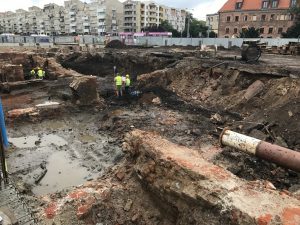Excavations by the Nowy Targ (New Market) town square in Wrocław, Poland, unearthed remains of Medieval houses and artefacts revealing how the city looked before destruction during World War 2.

Archaeological investigation is connected with future development of an office building at the site. Prior to 1945 the area of Wrocław’s Old Town was covered with Bourgeois buildings. Most of them were destroyed when the Nazis turned the city into a fortress and refused to surrender to the Red Army which nearly raised the buildings to the ground. Among the ruins of Medieval buildings archaeologists recovered artefacts including a fragment of a Romanesque sculpture.

According to the experts the statue is a very rare specimen and example of high quality workmanship. A mystery remains what this 12th century piece was doing in a building demolished in 14th century. Researchers believe that the house burnt down and was afterwards demolished. The head was cut off from a sculpture of a bearded man with detailed facial characteristics. It is possible that the fragment came from the Cathedral building in Wrocław, which was re-build few times around 14th century. These works involved removal of Romanesque elements. It is also possible that the fragment comes from the abbey in Ołbin, which contains similar works of art.

Together with the head a trove of 87 spindle whorls where found. It is believed all these artefacts were stored in some kind of a container. Other finds include a piece of a glass ring, a metal sheet with intriguing cut marks, numerous pottery vessels dating back to 14th-16th centuries, and a couple of German helmets from World War 2.

(after Instytut Archeologii Uniwersytetu Wrocławskiego, Bartłomiej Paulus & RMF24)